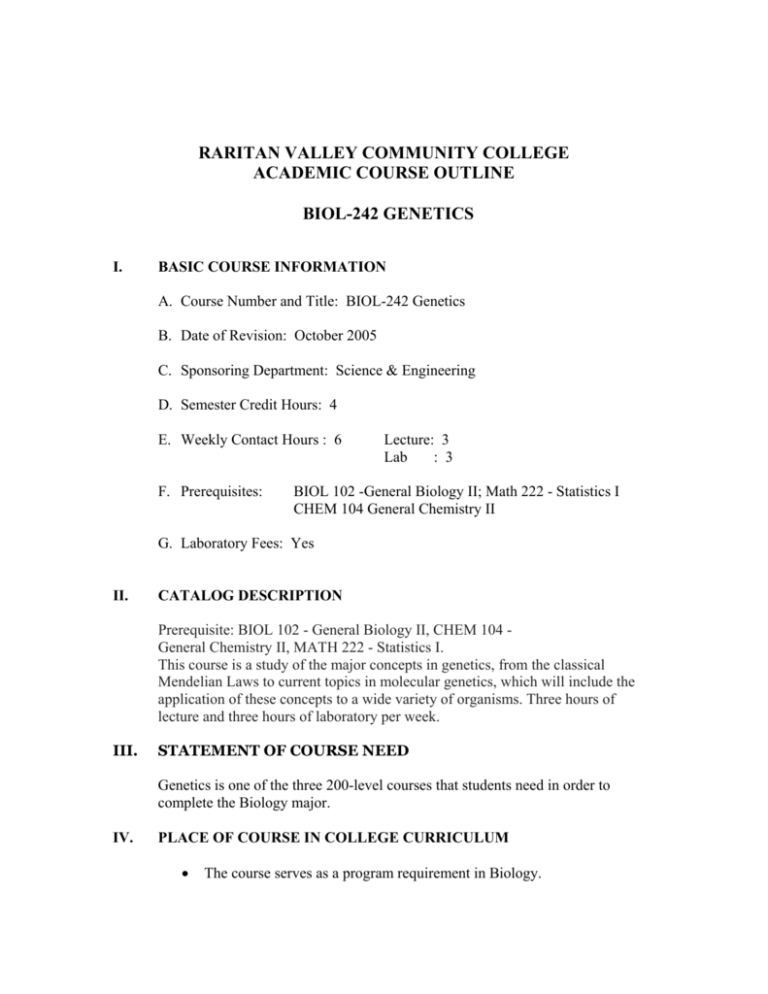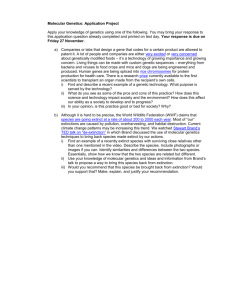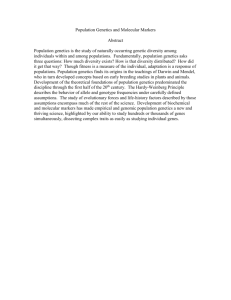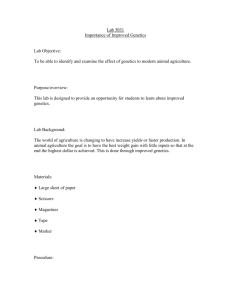
RARITAN VALLEY COMMUNITY COLLEGE
ACADEMIC COURSE OUTLINE
BIOL-242 GENETICS
I.
BASIC COURSE INFORMATION
A. Course Number and Title: BIOL-242 Genetics
B. Date of Revision: October 2005
C. Sponsoring Department: Science & Engineering
D. Semester Credit Hours: 4
E. Weekly Contact Hours : 6
F. Prerequisites:
Lecture: 3
Lab
: 3
BIOL 102 -General Biology II; Math 222 - Statistics I
CHEM 104 General Chemistry II
G. Laboratory Fees: Yes
II.
CATALOG DESCRIPTION
Prerequisite: BIOL 102 - General Biology II, CHEM 104 General Chemistry II, MATH 222 - Statistics I.
This course is a study of the major concepts in genetics, from the classical
Mendelian Laws to current topics in molecular genetics, which will include the
application of these concepts to a wide variety of organisms. Three hours of
lecture and three hours of laboratory per week.
III.
STATEMENT OF COURSE NEED
Genetics is one of the three 200-level courses that students need in order to
complete the Biology major.
IV.
PLACE OF COURSE IN COLLEGE CURRICULUM
•
The course serves as a program requirement in Biology.
Course Transferability: The course transfers as a Biology requirement or a lab
Science elective.
V.
OUTLINE OF COURSE CONTENT
Part I – Heredity and Phenotype
1.
2.
3.
4.
5.
6.
Mitosis and Meiosis
Mendelian Genetics
Modifications of Mendelian Ratios
Sex, Determination, Sex Differentiation, and Sex Linkage
Linkage, Crossing Over, and Chromosome Mapping.
Quantitative Inheritance, Phenotypic Expression and Heritability
Part II – DNA – The Chemical Basis of Heredity
1.
2.
3.
4.
DNA – The Genetic Material
Nucleic Acids
Replication and Synthesis of DNA
The organization of DNA in Chromosomes
Part III – Genetic Variation
1.
2.
3.
4.
Variations in Chromosome Number and Arrangement
Mutation and Mutagenesis
Bacterial and Viral Genetics
Extrachromosomal Inheritance
Part IV – Gene Structure, Function, and Regulation
1.
2.
3.
4.
5.
Genes and Proteins
The Genetic Code
Synthesis of RNA and Protein: Transcription and Translation
Gene Structure and Organization
Genetic Regulation
Part V—Genomics, Proteomics and Genetic Engineering
1.
2.
3.
4.
5.
Genomic Sequences and Analysis
The Human Genome: The Human Genome Project
Genetic Engineering: Techniques
Proteomic Technology
Applications of Biotechnology
Part VI – Genetics of Organisms and Populations
1.
2.
3.
4.
5.
6.
VI.
Molecular Genetics of the Cell Cycle and Cancer
The Role of Genes In Development
Somatic Cell Genetics
Genes and Behavior
Population Genetics
Molecular Evolution
EDUCATIONAL GOALS AND LEARNING OUTCOMES
A. GENERAL EDUCATION GOALS
Students will
1. classify information (G.E. 1, G.E. 7);
2. analyze information (G.E. 1, G.E. 7);
3. synthesize information (G. E. 1, G.E. 7);
4. state a problem clearly (G.E. 1, G.E. 2);
5. compose hypotheses and problem solving strategies (G.E. 1, G.E. 7);
6. assess hypotheses and problem solving strategies (G.E. 1, G.E. 7);
7. interpret information (G.E. 1, G.E. 7);
8. discover information through research (G.E. 1, G.E. 3);
9. identify clearly defined and suitable research topics (G.E. 1, G.E. 3);
10. report on their analyses of research information (G.E. 1, G.E. 2, G.E. 3);
B. LEARNING OUTCOMES
Students will be able to
1. interpret genetic data accurately;
2. analyze genetic data;
3. synthesize research results for the purposes of discussion and written
work;
4. conceive reasonable inferences in response to observations;
5. operate molecular data bases;
6. analyze genetics problems systematically and logically.
VII.
MODES OF TEACHING AND LEARNING
Formats, modes, and methods for teaching and learning may be:
• lecture/discussion
• small group projects/laboratories
• student oral presentations
• student collaboration
• independent study
VIII. PAPERS, EXAMINATIONS, AND OTHER ASSESSMENT
INSTRUMENTS
Assessment methods may be:
•
•
•
•
•
IX.
safe and effective laboratory practice
computer-based data mining
presentation of research findings
analysis of experiments in teams
other, as specified by instructor
GRADE DETERMINANTS
In order to evaluate achievement of the goals and outcomes listed above, possible
grade determinants may be:
Formal take-home papers
Discussion questions
Exams and quizzes
Research projects and/or collaborative project
Laboratory reports
Class participation and preparation
X.
TEXTS AND MATERIALS
•
•
•
•
textbooks
primary sources
web sources
databases
Samples of specific text that may be featured:
XI.
•
Genetics, A Conceptual Approach, Benjamin Pierce, W.H. Freeman
Publishers, Most Recent Edition
•
Concepts of Genetics, William Klug, et al., Pearson/Prentice Hall, Most
Recent Edition
RESOURCES
Students will need to use library databases and other library resources for critical
research assignments.









